BY FLORENCE BETT-KINYATTI
In the six years
“Tell me, Florah, in the six years of running your business here at Trio Crafts, was there ever a time you considered closing shop and walking away?”
“Yes,” says Florah, exasperating, “and not just once but several times. 2015 through to 2016 were not good years for us, especially 2016. I wouldn’t regret it if that year was erased from my mind.” Florah chuckles. “Business was bad because of the terrorists attacks, so tourism in the region was badly affected. Most of our clients are the hotels and lodges in Kenya, Uganda and TZ, and if they didn’t have business we also didn’t have. Our other clients are individuals, mostly expatriates, who buy these rugs for their homes. But these rugs are not a necessity–”
“They’re sort of a luxury item,” I offer.
“Yes,” Florah says, “so it’s something that people can do without. There were months where I didn’t make enough to pay the salaries of my 10 weavers.” Florah adds when I ask, “Yes, I pay them a salary at the end of month based on the number of rugs they’ve completed, it doesn’t matter if I have sold that rug or not, that’s how we’ve always done it.
“These weavers are from Kibera slums – Trio Crafts was set up in 1993 by an Ethiopian lady, her name was Elizabeth Kassa. She set up the business as an empowerment program for women in Kibera; she taught them this old traditional Ethiopian art of weaving the rugs by hand so that they could earn an income from selling them and improve their lives from this income. So in 2016, when business was doing badly, I thought of my weavers and those who had been in the business since 1993, where would they go with no jobs and no source of income? It wasn’t a thought I could entertain, so I weathered through.
“Business picked up again in early 2017. Last December, we sold 50 rugs and 300 placemats.”
A brief history of Trio Crafts
Trio Crafts & Rugs Limited is a local enterprise that hand makes rugs, bathroom mats, table place mats, curtains and throws. The rugs are made from 100 per cent natural wool. The placemats and bathroom mats, curtains and throws are made from either pure cotton or from acrylic.
Here’s its brief history: Trio Crafts was set up in 1993 by an Ethiopian woman called Elizabeth Kassa. She set it up as an empowerment program for women in Kibera slums. It was called Trio Rugs Limited.
In 2005, Elizabeth passed the baton to Abraham Ayele and his wife. They continued in the mission for empowerment and changed the name of the business to Trio Crafts & Rugs Limited.
Abraham Ayele and his wife were friends to Florah’s husband, he’s the one that introduced Florah to them. One time, in mid 2005, Florah nicked in to Trio Crafts on a lark and bought some placemats for her house. She liked them so much that she bought plenty more others for resale to her pals at the office where she worked, at Telkom Kenya.
“I’d buy one placemat for 200 shillings and sell them to my colleagues for 300 shillings.”
“And what did you colleagues like about these placemats?”
“That they were well-made. And they were durable and unique. And they looked beautiful on their tables because of the nice colours.”
“How long did you run this side-hustle for?”
“For two years,” says Florah, “from 2005 to 2007. I was running the business to make some extra money, yes, but also because I was bored at work. I was a Billing Manager at Orange Kenya, and I’d already stopped growing in my career. I had reached a point where I was doing the same kawaida thing over and over again. I eventually left in 2008 but I really wish I had left sooner.”
“And had you always been with Orange?”
“Yes, I joined the company in 1991. Back then it was KPTC, Kenya Post and Telecommunications Cooperation. I joined them in marketing but ended up doing systems work. I majored in marketing when I was in Uni. I grew with them as the company split and morphed into Telkom Kenya, then to Orange. That’s where I was before opting for early retirement.”
“What do you remember about the time you left Orange? What were your fears?”
Florah pauses and says carefully, voice lowered. “I really wished I had left earlier. I always had a sixth sense but I ignored it. I should have listened to it because that was my passion speaking, that was where God was leading me to go.”
“And where did you grow up?”
Florah cracks a shy smile. “I grew up in this village in Eldoret called Sochoi Village.”
“Had you always been into art, were you always good with working with your hands?”
“Yes! I’m the last born at home and my mother used to knit these sweaters for school children. I remember that I’d sometimes sit next to her and watch her knit but she’d never let me touch her needles, ha-ha. One day when she was away, I was about eight, I knitted something really good. It’s my aunt who later bought me my own needles when I was 14. I continued knitting, even campus I used to make my own clothes.”
A Tuesday in the fervour of February
It’s a Tuesday in February Nairobi. One of these hot days we’ve had in the last couple of weeks. You must have received that WhatsApp forward which says that experts say the fervour is “stemming from an emission of greenhouse gases”, and that we must “adopt some smart strategies and practices to cope with heat”.
On any other day I would have ignored the forward, but on a Tuesday like today, it explains the intensity. Nairobi feels like it’s too close to the Sun.
Florah and I chatting from the living room of a bungalow that sits on 3/4 acre of prime property at the junction of Dagoretti Corner and Ngong Road, right next to the KenolKobil. Let me give you location: Imagine it’s a human head of a body that’s looking straight into the sky: you’ll see Nakumatt Junction to the right ear, to the left is the start of Dagoretti Corner and the long tongue of Naivasha Road. Florah’s property is the nose, and at its tip is a KenolKobil petrol station. The chin of this face is that gaping junction where Dagoretti Corner, Naivasha Road and Ngong Road collide.
To drive through Trio Craft’s gates, you have to take what feels like a very foolish and very dangerous swerve off this particular junction then quickly slow down to manoeuvre the very high bump that surprises you before you go through the gates.
Past the gate and inside the property, I feel like I’ve been transported back to 1993 and Moi is still in power and Nairobi folk in the city still live in bungalows and maisonettes, not with the pesky neighbours in flats and apartment blocks; neighbours who tell you that your toddler is making too much noise playing in the house, and that you shouldn’t bang doors or drag furniture or race each other down the corridor because the noise reverberates then echoes and amplifies in her house to the point where she can’t peacefully live in her own space.
On this prime property is a five-bedroom bungalow, a double servant’s quarter, a two-car garage and a high-ceiling mabati roof workshop tucked in the back. It even has a roundabout in the driveway. Everything about this place is stuck in the sliver of an era – its shrouded in nostalgia; an old part of the city that’s a snapshot of what defined urbanity for a stint we now yearn for.
“Is this property yours?” I ask her later, when were outside looking at one of the weavers snip the excess threads from a rug he’s just completed.
“No,” Florah says, “I’m renting it.”
“Renting from who?” I ask nosily.
“From some old Luhya couple. I’ve been renting it from them since I moved here in 2012. But it’s been like this all through, in the same state…,” Florah trails off as she points to the uneven driveway where clouds of dust violently rise up with the mere creep of footsteps. Our eyes then pan to the car garage where the eaves are hanging by a godlike mercy with their old paint chipped, then to the broken lawns where snipped balls of cotton roll around in the gravel, then to the double SQ that effuses this energy of dark haunted secrets. And finally to the workshop, where the indistinct chatter from the weavers at work and their little transistor radio waft into the crackling atmosphere.
“They don’t want to make any improvements to the house or to the gardens, they want to leave it as it has always been. It was actually like this when we moved in.”
The living room has been converted into a showroom, it’s also where Florah’s single-desk office is.
We sit here to chat.
The rugs, folded in neat piles and hanging from the wall-ceiling, surround us as if they are an eavesdropping audience – mute, attentive, judgemental and passive.
Florah Bore is 49
Florah Bore is 49 years – married, they have two daughters; 22 and nine years old.
She took over the business in April 2012.
She says, “My husband got a job in Ethiopia in 2008, it’s the same year I retired from Orange.” It was technically early retirement because she was only 40 at the time. “We relocated to Ethiopia in 2009, my husband and our two daughters. My youngest was only nine months old at that time, so when we got to Ethiopia, I stayed home to take care of her. But, before we left, I went to Trio Crafts and told the owners that if they ever consider selling the business that they should consider me first.”
“And how was life in Ethiopia?”
“Life wasn’t easy, mostly because of the language barrier. Schools and universities taught in Amharic, everyone spoke in Amharic, even the nannies; it’s only the old people who could converse with me in English.”
I ask her to share an experience. She laughs then says, “I remember this time I was baking bread at home and had run out of flour. So I went to the shop to buy the flour. I knew what flour was in Amharic – it’s duketi – but the guys at the shop couldn’t understand me, it was really frustrating. Ha-ha. So as I’m leaving the shop I bump into this old man and ask him to tell the shopkeeper that I want flour. Ha-ha
“We lived in this part of town called Bole before moving to Hayaulet. When my daughter was a little bit older, I studied for my masters in finance, I took an online degree.”
“In April 2012, Abraham and his wife emailed me saying they wanted to move back home to Ethiopia and were ready to sell the business to me.”
“Off the record, for how much?”
Florah tells me the figure. It’s a couple of millions. She and her husband pulled cash from their savings and they closed the deal that April. Florah and their two daughters relocated to Kenya that June, and moved to Dagoretti Corner, where she now runs the business.
This initial investment bought her the business and trade name, goodwill, unsold inventory, raw materials, the bungalow-to-let where she now lives, the workshop and 16 weavers (14 women and 2 men). Florah says, “Some of the weavers have since retired, others have gone on to start their own business. I’m now left with 10, they’re now training two other weavers. It’s just this year that we’ve started to train other weavers.”

Some completed rugs in Trio Crafts’ showroom
We get the wool from sheep farmers in Maasailand
“Let’s talk about the process of weaving the rugs, Florah, from the point where you source the wool.”
“OK, so we get the wool from sheep farmers in Maasailand, that’s Kinangop, Narok, and also from Nakuru and Limuru. This is the wool that has been shaved from the sheep, the locals call it ‘manyoya’, a kilo sells for between Sh160 and Sh200.
“This wool has to be spun and plied into double threads in a bobbin before we can use it for weaving our rugs. So we take it to some spinners in those areas and they spin it for us by hand. A kilo of spun wool is Sh400. The locals call this spun wool ‘uzi’. 4 bobbins make up one kilo.”
“Don’t you have your own spinners?”
“No, we don’t. It’s expensive to hire spinners here for the day. Plus it takes a long time to spin raw wool – it can take a whole day to get 2 kilos of spinned wool. But I’m planning to train my own spinners this year. I’ve been playing it safe and not taking risks in this business,” Florah giggles, “so I’ve not taken gotten my own spinners. Speaking business sense, yes, it’s better to have your own in-house spinners that buying spun wool or hiring spinners.
“The bobbins of this spun wool are usually very dirty, they have oil and lanolin and a strong odour.” I’d later smell a bobbin of spun wool – it smells of sheep excreta, rain and sunshine, farmland and the sweat, care and toil of the hands the wool has gone through to get here. It short, it smells of a long story.
Florah continues, “We wash the bobbins by hand using warm water and Panga bar soap. Detergent is harsh on the wool so we don’t use it. We had also made some soap of our own, the women in the self-help program made, but it was too harsh on the wool and on the hands, so we stopped using it. There’s someone whose job is to wash them, it takes him about an hour to wash 50 bobbins. They’re brown before they go into the water, when he’s finished with them they are white. We put them in a machine to spin out the water.
“The white wool is treated then hung on the clotheslines to dry, they are treated with a solution called Mittin. The wool that needs colour is dyed in a sufuria of solution over jiko. 20 litres of water need about two teaspoons of dye and a lot of salt. The deeper the shade of a colour we want, the longer it boils in the sufuria – sometimes it only needs 45 minutes, sometimes two hours. After dyeing, they sundry on the lines then the dried dyed wool goes into the workshop for weaving.”
“Where do you get the dye and treatment from?”
“They’re from Industrial Area, there are chemical companies which sell them.”
“And will this dye run when a client washes the rug at home?”
“No, it doesn’t. It holds very well because of the salt we add to the solution. The dye and treatment also prevents moths from eating the rug.”
In the workshop
“In the workshop,” Florah carries on, “the weavers set up a wooden frame to do the weaving. The warps are these 9–ply cotton threads we buy from Industrial Area, the weft is the spun wool. For the shaggy rugs, the warp and weft is wool.” Warp and weft, I could never be able to tell which was vertical and which was horizontal. Can you?
“Don’t they use looms?”
“No, we only use looms to make the bathroom mats. We’re even using the cotton from t-shirts to make them. No, no, it’s brand new t-shirts, not old ones. We have an order from a lodge in Uganda, they want 300 mats. What’s taking the weaver a long time is to complete one rug is getting the weaving strands from the t-shirts.”
(Google the image of a loom to understand what it is.)
“How many kilos of spun wool do you use in one day?”
Florah thinks for a second, “Mmh, about 50 kilos. Sometimes more, sometimes less. Depends on the client orders we have that day.”
Depending on the size of the rug, the intricacy of the patterns and the skill of the weaver, it can take between two to five days to weave an 8-by-10 rug for the living room, and a day for a 2-by-4 bedside rug. Two weavers work on the bigger rugs that have intricate patterns.
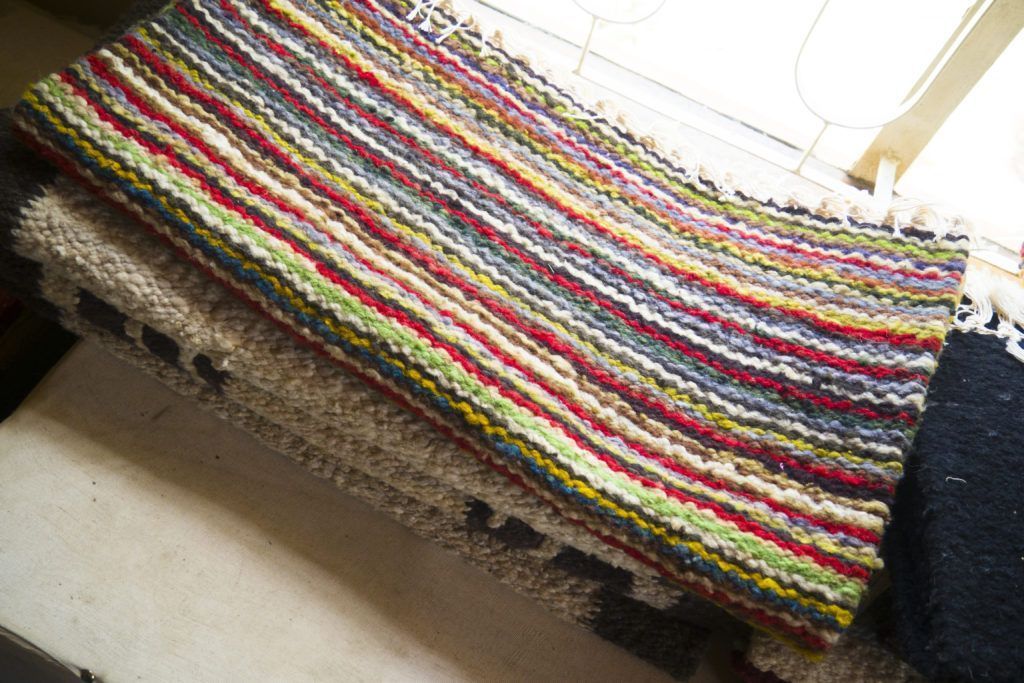
Some completed rugs in Trio Crafts’ showroom
“You can’t be allergic to these rugs unless you are allergic to natural wool itself.”
“Now, this rug is made out of pure and natural wool, Florah, it looks like it can be something that can cause allergies.”
Florah chortles. “You can’t be allergic to these rugs unless you are allergic to natural wool itself.”
“Mmhh…”
“And what people don’t know is the wonderful properties of natural wool. Wool keeps the air in a room clean because it locks in the dust. It regulates the temperature in a room and keeps the room cool, that’s why it can also be used in Mombasa because it regulates the humidity. Unlike rugs made from synthetic materials, wool chars, it doesn’t burn. There’s a woman who said that her rug saved her house from burning down. It was against the wool and it stopped the fire from spreading to the rest of the house.
“Wool is also durable; there’s a client who said she’s had her rug for 15 years and says it looks just as beautiful as when she got it. In fact, most of the repairs we’ve done to the rugs are because a puppy or some pet has chewed it.”
“And how do you keep it clean?”
“Hoover with a machine or take it outside and beat it to remove the dust. You can also wash it at home using cold water, a soft brush and bar soap; don’t use detergent because it’s harsh on the wool. And don’t let it stay in water for too long because it’ll make the rug rot and the fibres to disintegrate. Hang it out in the sun to dry. Remember, you can use both sides of the rug.”
“What do your clients love about these rugs?”
Without skipping a beat, Florah says, “That they’re beautiful, long-lasting, unique. They also like that they can customize they own patterns on the rug. In fact most of our clients ask that we don’t replicate their pattern on another client’s rug. There’s one client who sent me a picture for his rug and said never to show anyone that pattern. Ha-ha.”
“And what do you see when you look at these rugs, Florah?”
Florah’s face softens then she says, “I see more than a rug – I see beauty. I see art. I see something valuable. I love that I’m able to translate a person’s desires into a beautiful rug.”
Later, when Florah and I walk around the grounds as she shows me the process, I ask, “Tell me this, Florah, supposing someone comes here and wants to steal your intellectual property, what would they steal from you?”
Florah pauses and looks around, as if the response to that question is standing behind her. “There’s nothing to steal, really,” she says, stifling a laugh, “if someone wants to steal my intellectual property then they steal my weavers; they’re the ones who hold the intellectual property, they’re the ones with the skill. They’re gifted people.”
**
What Trio Crafts & Rugs offers
> Living room rugs measuring atleast 8 by 10 feet: Sh45,000 to Sh60,000
> Bedside rugs measuring atleast 2 and a half by 4 feet: Sh4,500 to Sh6,000
> Table place mats made from cotton: Sh350 each
> Bathroom floor mats made from cotton: Sh350 per sq/ft
> Curtains made from cotton: Sh.1,200 per metre
> Throws made from cotton: Sh1,800 to Sh2,000 per meter
Reach Florah of Trio Crafts & Rugs
Phone number: 0708-848300
Email: [email protected]
Facebook: Trio Crafts & Rugs Ltd
YouTube
Watch the video on our YouTube Channel here >> Florah of Trio Crafts & Rugs Ltd
Photo credits: All photos by Aegean Will, for Craft It.
None of these photos should be used elsewhere without the express permission of Craft It.
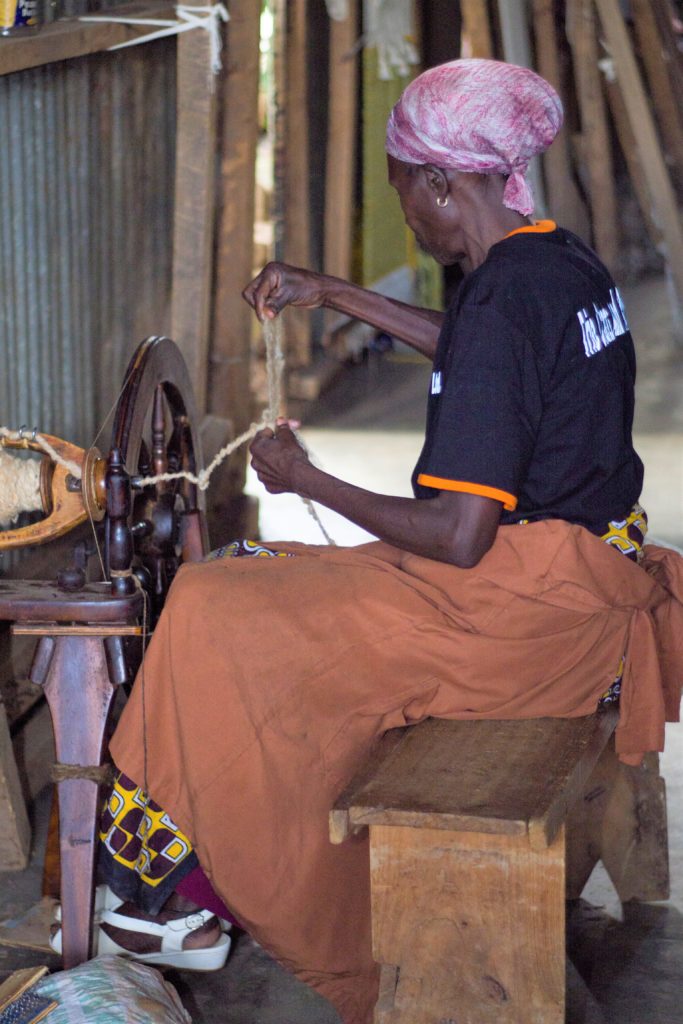
Step 1: The wool is spun by hand and plied into double threads
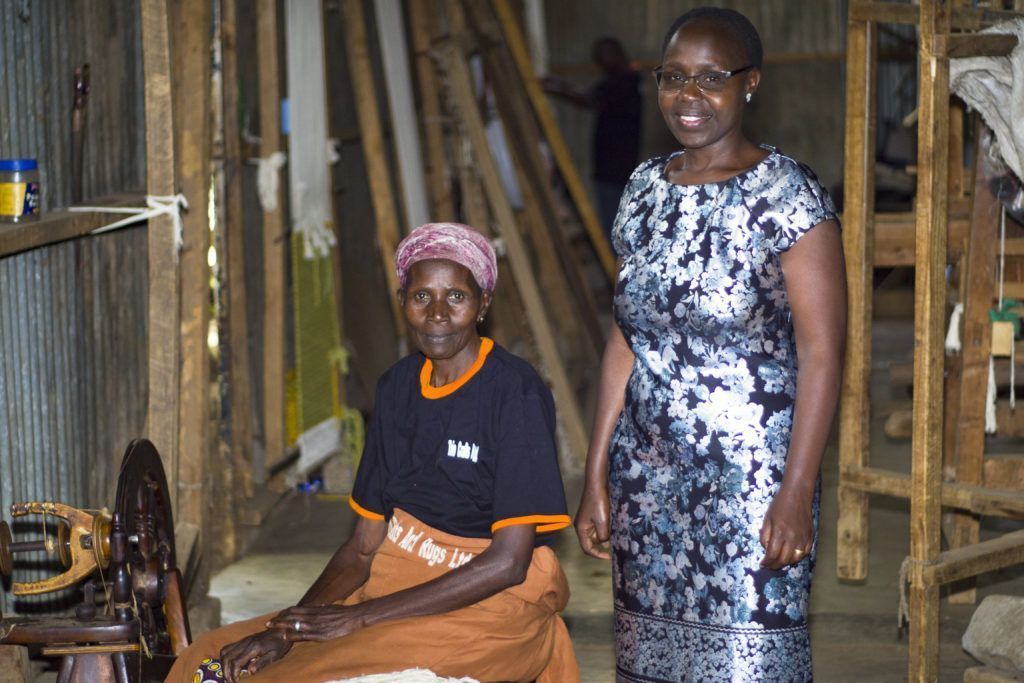
Florah with one of the spinners she sometimes works with
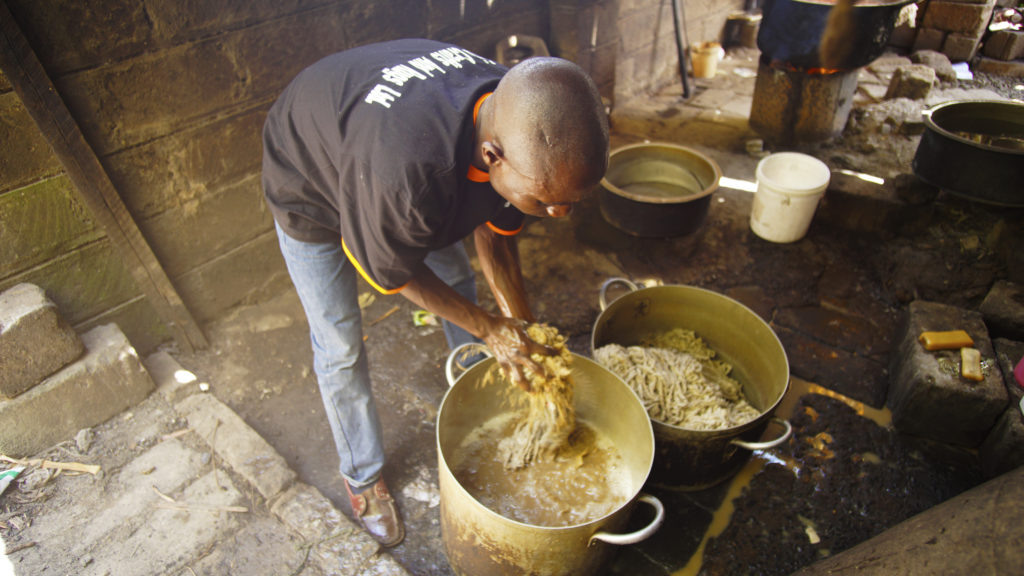
Step 2: The spun dirty bobbins of wool is washed by hand using bar soap
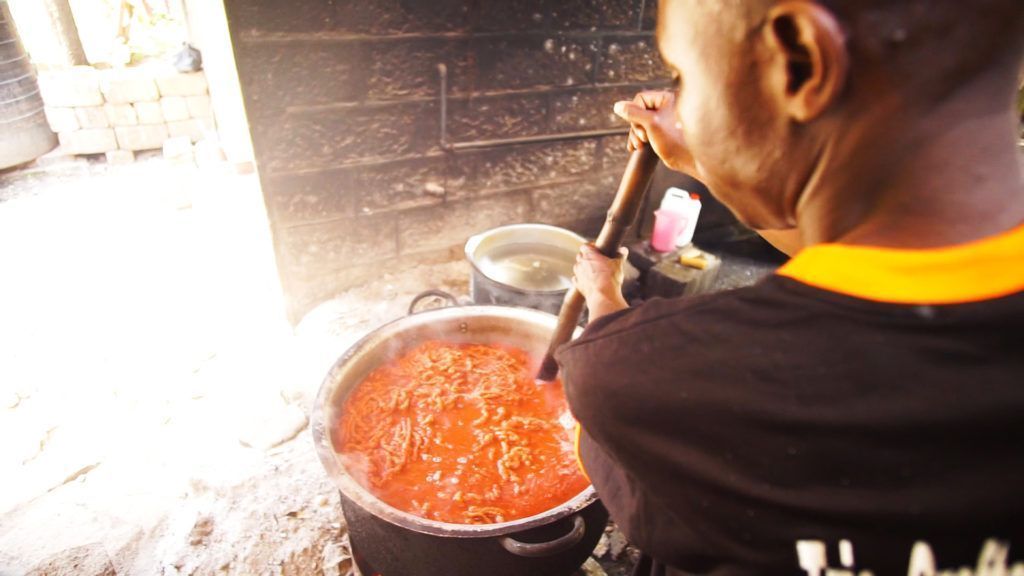
Step 3: The cleaned wool is dyed in a large sufuria of boiling water and dye
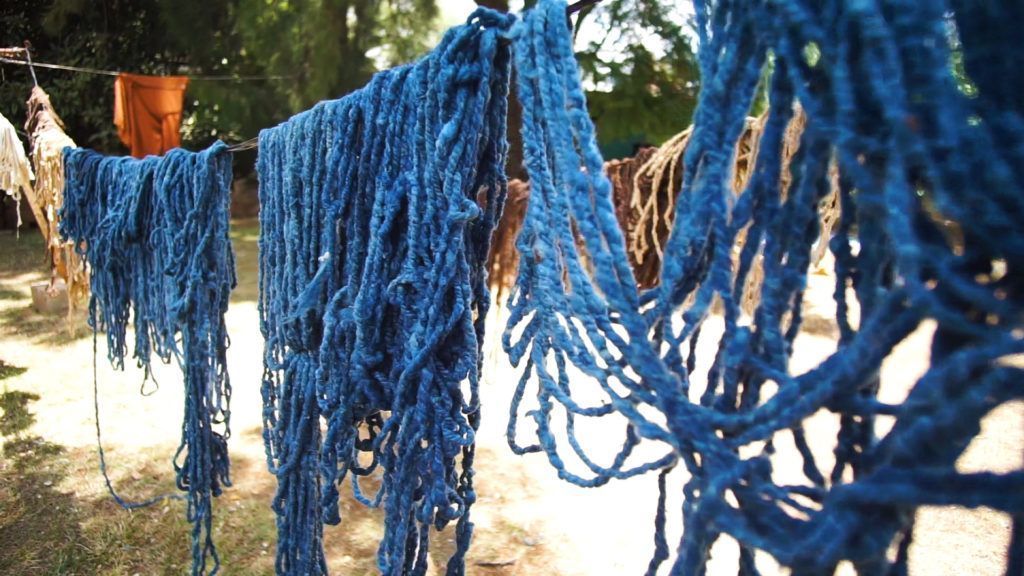
Step 4: The dyed wool is dried in the sun

Step 5: The weavers in the workshop set up the frames to weave the rugs

Step 5: The weavers in the workshop set up the frames to weave the rugs
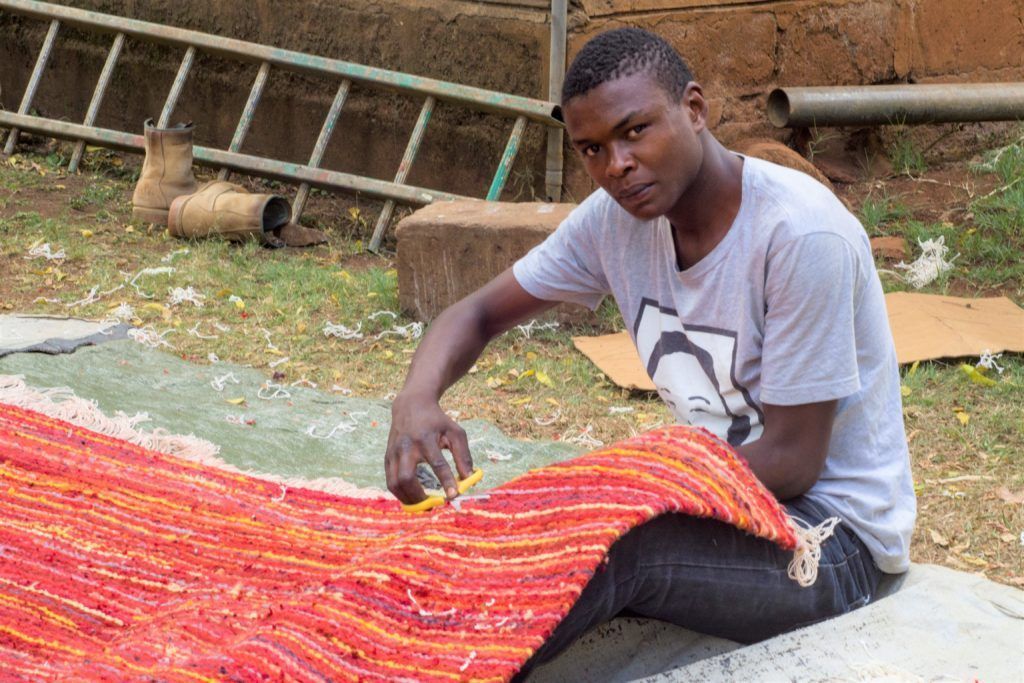
Step 6: A weaver snips off the excess surface threads using a pair of scissors

Step 7: A weaver knots the fringes of a completed rug

Some completed rugs in Trio Crafts’ showroom
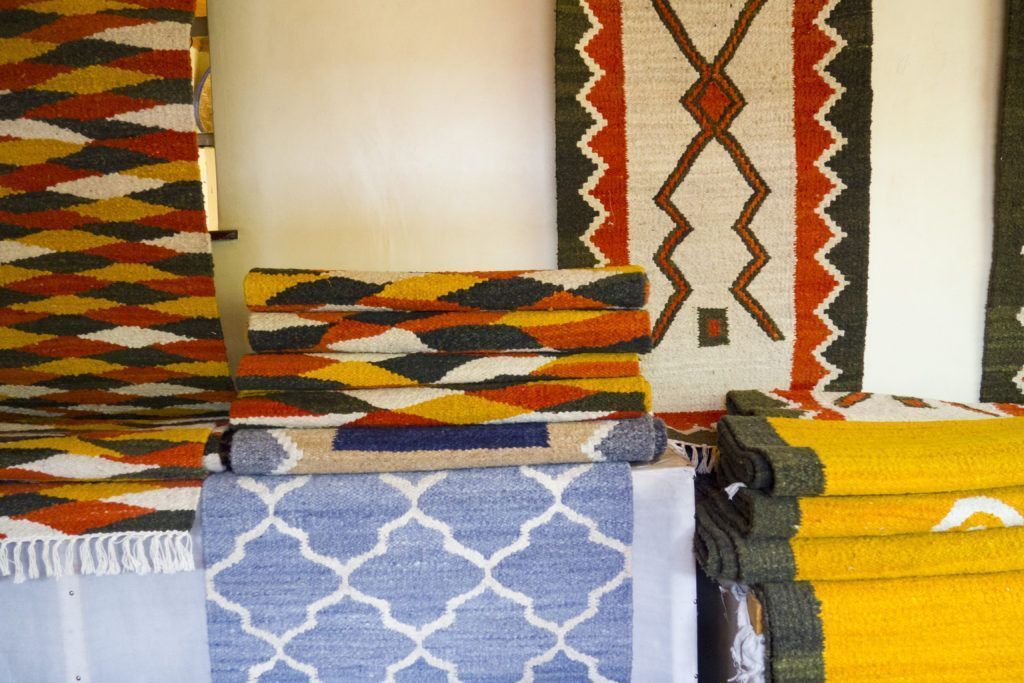
Some completed rugs in Trio Crafts’ showroom
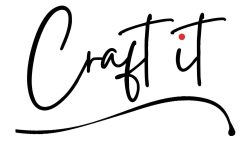
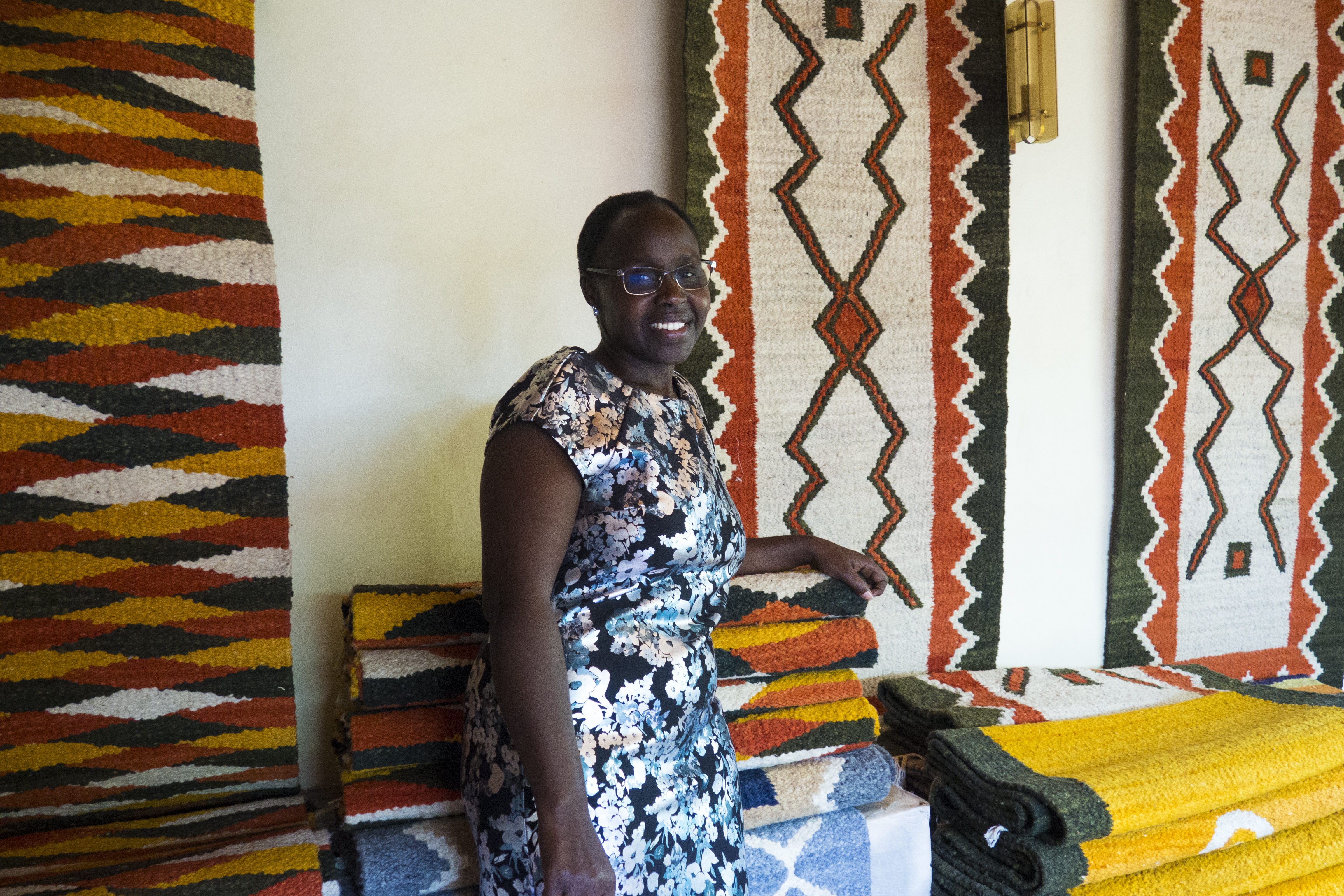
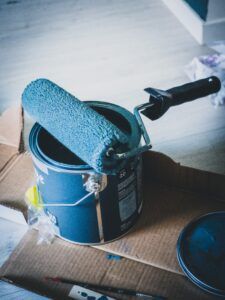
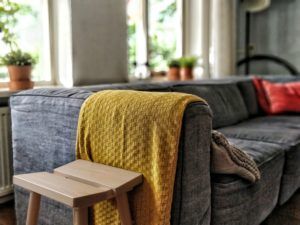
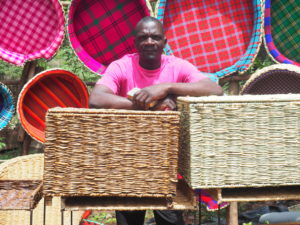


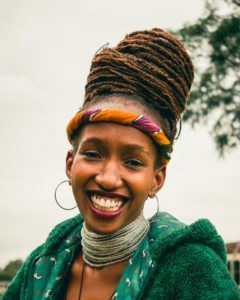
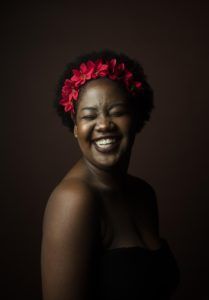
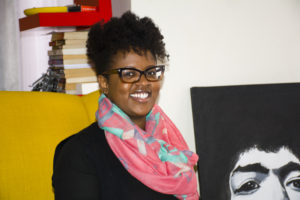



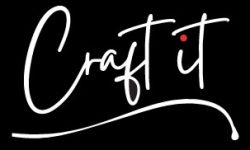

Hi am john muthiani and I have the skill of making carpets and dying am requesting for job please please